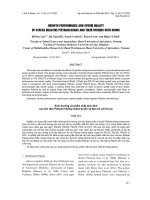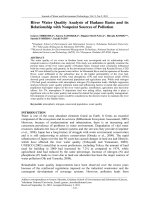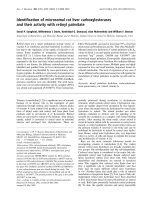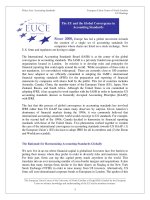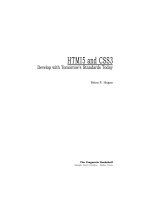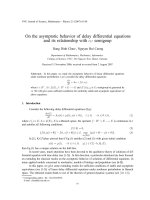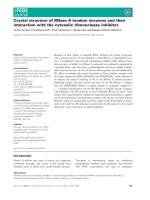IAS and their relationship with czech accounting standards
Bạn đang xem bản rút gọn của tài liệu. Xem và tải ngay bản đầy đủ của tài liệu tại đây (104.64 KB, 37 trang )
IAS (IFRS) and their
relationship with Czech
accounting standards
Created and directed by
Petr Valouch
Accounting of the enterprises in
the Czech Republic
All enterprises in the Czech Republic have the obligation to
keep accounting files
This obligation is determined by the law of accounting nr.
563/1991
The last amendment of this law has been valid since the
beginning of the year 2004
During last 3 years the law has been changed for several
times with the aim to approximate Czech juridical
regulation to European juridical regulation
The European accounting system
is based on two pillars
Directives of the European Union
International Accounting Standards (IAS). The
newer term for IAS is International Financial
Reporting Standards (IFRS)
The Czech law of accounting has accepted a lot of
assignments embedded in IAS and Directives with
the aim to synchronize Czech and European
juridical rules before entering the Czech Rep. to
the EU.
Czech accounting
Czech accounting knows two systems:
Single-entry accounting
Double-entry accounting
But: Single-entry accounting can be used only in
case of some non-profit institutions.
Situation of the Czech accounting
after entering to the EU
Only one system of accounting will stay from the
year 2005 – double-entry accounting
Firms whose turnover will be lower than 6 mil. CZK
per year will be able to keep so called tax
evidence of incomes and expenditures
Firms whose turnover will be higher than 6 mil.
CZK will have to keep obligatory double-entry
accounting.
There can be no exceptions!
Double-entry accounting in the CR
From 2005 will be the only possibility how to keep
accounting files
Means that all economic transactions in firm are
accounted on two correlated accounts
Example: Firm buys material (value is 100 CZK–
accounting document is an invoice bill)
Material on stock
100
Commercial debts
100
Main rules valid for accounting
Accounting must be complete, correct and
conclusive.
Accounting is complete when all economic
transactions are charged on accounts
Accounting is correct when no law and instruction is
broken
Accounting is conclusive when all economic
transactions can be attested by some accounting
document.
All these rules must be kept together!!
Purpose of accounting
Accounting gives information to owners,
managers, employees, creditors, banks, financial
institutions and other external subjects about
economic and financial situation of the enterprise.
Financial statements are obligatory rendered to
the revenue authority, because they pose the base
for compilation of tax declaration.
Financial statements are also obligatory rendered
to the commercial register.
In case of larger firms their financial statements
are the part of their annual report.
Financial statements
At the end of the accounting period all firms in the
CR must compile 3 basic financial statements:
1.
2.
3.
Balance sheet – provides information about assets
and liabilities of the enterprise.
Profit and loss statement – provides information
about costs, revenues and economic result of the
enterprise.
Appendix – provides other information not included
into balance sheet and P/L statement – accounting
methods, valuation rules, allowances for
depreciation, etc.
Cash-flow statement in the CR
Its compilation is not obligatory, but it is suitable to compile
it (optionally compiled statement).
Provides information about financial flows in the company,
it means about incomes and expenditures.
Adds obligatory compiled statements, especially P/L
statement.
Is a part of appendix.
Is often asked when enterprise applies for credit, because
it provides better information about real financial situation
than P/L statement.
Differences between cash-flow
statement and P/L statement
Result from so called accrual principle of
accounting.
Accrual principle means that enterprises charge
revenues and costs on accounts regardless to the
fact whether real movement of cash (income or
expenditure) happened.
Costs and revenues must be charged in the period
they objectively and timely relate to. In other case
costs and revenues must be timely differentiated to
keep the previous condition.
General accounting principles
Caution principle – assets and revenues must not
be overvalued and liabilities and costs must not be
undervalued
Independence of the accounting periods –
economic transactions must be charged in the
period they are connected with
Definition of the realization moment – it must be
strictly defined the moment when enterprise can
charge on accounts
Definition of the accounting unit – it means the unit
that keeps accounting files and compiles financial
statements
Restriction of compensation – mutual compensation
of accounting items is strictly limited and it is
possible only in very special cases (for example in
case of receivables and debts to the same subject
with the term of payment shorter than one year that
are charged in the same currency)
Going concern – presumes unlimited continuance of
the firm
Accounting methods stability – firm must not change
its accounting methods during the accounting
period. Each exception must be justified by the aim
of better expression of reality
Historical costs – this principle means that
property valuation is made in the moment of its
acquirement
Balance continuity – balance-sheet compiled at
the beginning of an accounting period must
correspond with the balance sheet compiled at the
end of the previous accounting period
Materiality principle – financial statements must
contain informations that are important for all users
from the point of their future decisions
Objectivity principle – accounting must be
complete, correct and conclusive
Again: all these principles must be kept together!!!
European accounting harmonization
Need of European accounting harmonization
arose from the formation of the EU in 1957 and it
is berthed in foundation treaty (so called Roman
treaty)
Harmonization has been created by accepting and
transforming European directives that have been
ratified by European Board of Ministers
European directives have not character of an
international law but they give a duty to accept
them in national law of the EU members
Directives of the EU
13 Directives have been ratified since 1957
The most important Directives are:
1.
2.
Fourth Directive – was ratified in 1978. This
Directive focuses on the unification of financial
statements in member countries of the EU.
Seventh Directive – was ratified in 1983. This
Directive concerns compilation of consolidated
financial statements that must be compiled by
groups of enterprises (holdings, concerns, etc.)
3.
Eighth Directive – was ratified in 1984 and
determines minimal requirements for auditors
qualification.
IAS (IFRS)
International Accounting Standards (respectively
International Financial Reporting Standards)
represent the second basic pillar of the European
accounting system
IAS are issued by The International Accounting
Standards Committee (IASC). IASC came into
existence on 29 June 1973 as a result of an
agreement by accountancy bodies in Australia,
Canada, France, Germany, Japan, Mexico, the
Netherlands, the UK and Ireland and the USA.
The objectives of IASC
The objectives of IASC are set out in its
Constitution. These objectives are:
To formulate and publish in the public interest
accounting standards to be observed in the
presentation of financial statements and to
promote their worldwide acceptance and
observance, and
To work generally for the improvement and
harmonization of regulations, accounting
standards and procedures relating to the
presentation of financial statements
The objective of financial
statements
In according with IASC objectives the objective of
financial statements is:
To provide information about the financial position,
performance and changes in financial position of
an enterprise that is useful to a wide range of users
in making economic decisions. Financial
statements prepared for this purpose must meet
the common needs of most users. Financial
statements also show the results of the
stewardship of management, or the accountability
for the resources entrusted to it.
IAS 1 – Presentation of financial
statements
The objective of this Standard is to prescribe the
basis for presentation of financial statements, in
order to ensure comparability both with the
enterprise´s own financial statements of previous
periods and with the financial statements of other
enterprises.
To achieve this objective, IAS 1 sets out overall
considerations for the presentation of financial
statements, guidelines for their structure and
minimum requirements for the content of financial
statements (next it will be used abbreviation FS).
Purpose of FS in according with
IAS 1
Financial statements are a structured financial
representation of the financial position of and the
transactions undertaken by an enterprise.
FS provide information about an enterprise´s:
Assets
Liablities
Equity
Income and expenses, including gains and losses
Cash flows
Components of FS (in according
with IAS 1)
A complete set of FS includes the following
components:
a.
b.
c.
Balance sheet
Income statement (P/L statement)
A statement showing either:
i.
ii.
d.
e.
All changes in equity, or
Changes in equity other than those arising from
capital transactions with owners and distributions
to owners
Cash flow statement
Accounting policies and explanatory notes
Balance-sheet (IAS1)
As a minimum the balance-sheet should include these items:
Property, plant and equipment
Intangible assets
Financial assets
Investments accounted for using the equity method
Inventories
Trade and other receivables
Cash and cash equivalents
Trade and other payables
Tax liabilities
Provisions
Non-current interest-bearing liabilities
Minority interest
Issued capital and reserves
Income statement (IAS 1)
As a minimum the income statement should include these
items:
Revenue
The results of operating activities
Finance costs
Shares of profits and losses of associates and joint ventures
Tax expense
Profit or loss from ordinary activities
Extraordinary items
Minority interest
Net profit or loss for the period
